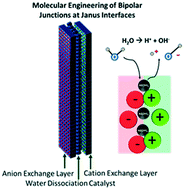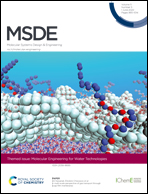Promoting water-splitting in Janus bipolar ion-exchange resin wafers for electrodeionization†
Abstract
Electrochemical separation processes are undergoing a renaissance as the range of applications continues to expand because they offer opportunities for increased energy efficiency and sustainability in comparison to conventional separation technologies. Existing platforms such as electrodialysis and electrodeionization (EDI) are seeing significant improvement and are currently being deployed for treating a diverse set of liquid streams (e.g., water and wastewater treatment, organic acid separation, etc.). In addition, the relatively low inherent electricity requirement for electrochemical separations could potentially be satisfied through integration with sustainable sources of renewable energy. In order to achieve a truly sustainable electrochemical separations process, it is paramount to improve the energy efficiency of electrochemical separations by minimizing all sources of resistances within these units. This work reports of a new class of symmetric and asymmetric Janus bipolar resin wafers (RWs) that augment the spacer channel ionic conductivity in EDI while having the additional functionality of splitting water into protons and hydroxide ions. The latter attribute is important in niche applications that require pH modulation such as silica and organic acid removal from liquid streams. The Janus bipolar RWs were devised from single ion-conducting RWs that were interfaced together to create an intimate polycation–polyanion junction. Interestingly, the conductivity of the single ion-conducting RWs at low salt concentrations was observed to be dependent on the ionic mobilities of the counterions that the RW was transferring. Using single ion-conducting RWs to construct Janus bipolar RWs enabled the incorporation of a water-splitting catalyst (aluminum hydroxide nanoparticles) into the porous ion-exchange resin bed. To the best of our knowledge, this is the first time a water dissociation catalyst has been implemented in the ion-exchange resin bed for EDI. The water dissociation catalyst in bipolar junctions pre-polarizes water making it easier to split into hydronium and hydroxide ion charge carriers under applied electric fields via the second Wien effect. The new molecularly layered Janus RWs demonstrate both satisfactory water-splitting and salt removal in bench scale EDI setups and these materials may improve, or even supplant, existing bipolar membrane electrodialysis units that currently necessitate large electrolyte feed concentrations.

- This article is part of the themed collections: 2021 MSDE Symposium Collection and Molecular Engineering for Water Technologies


 Please wait while we load your content...
Please wait while we load your content...
